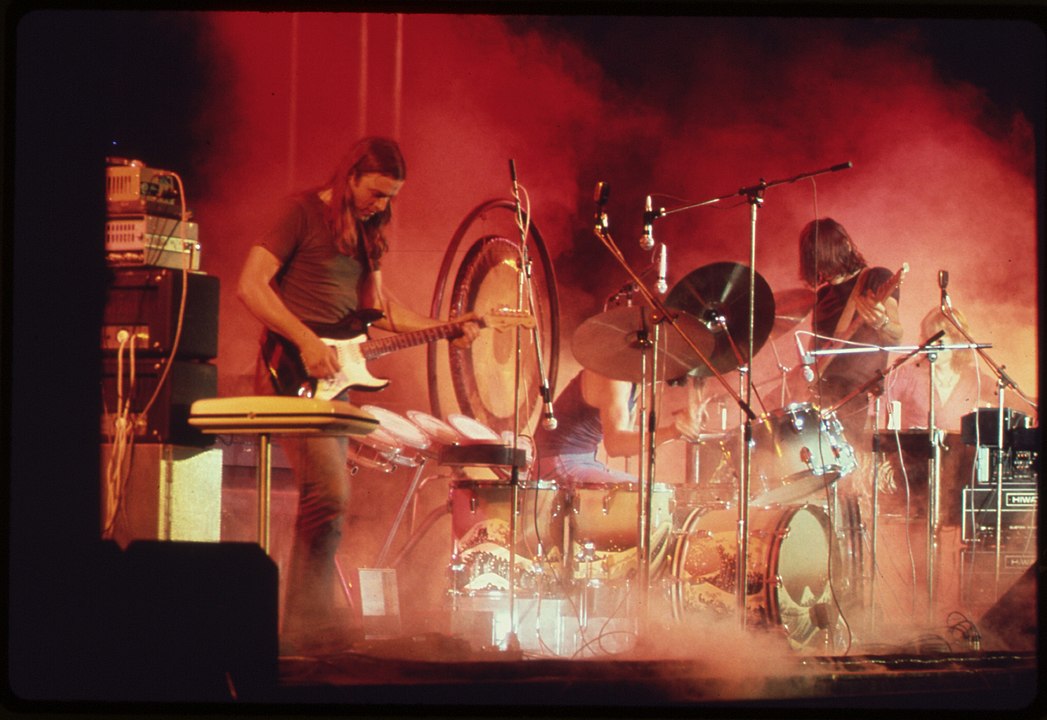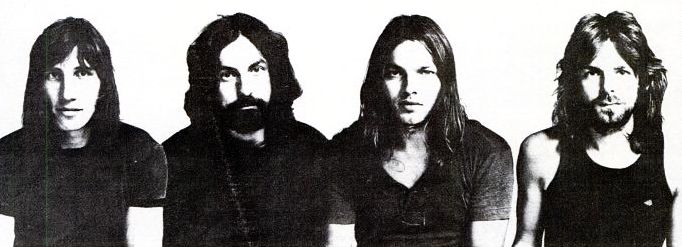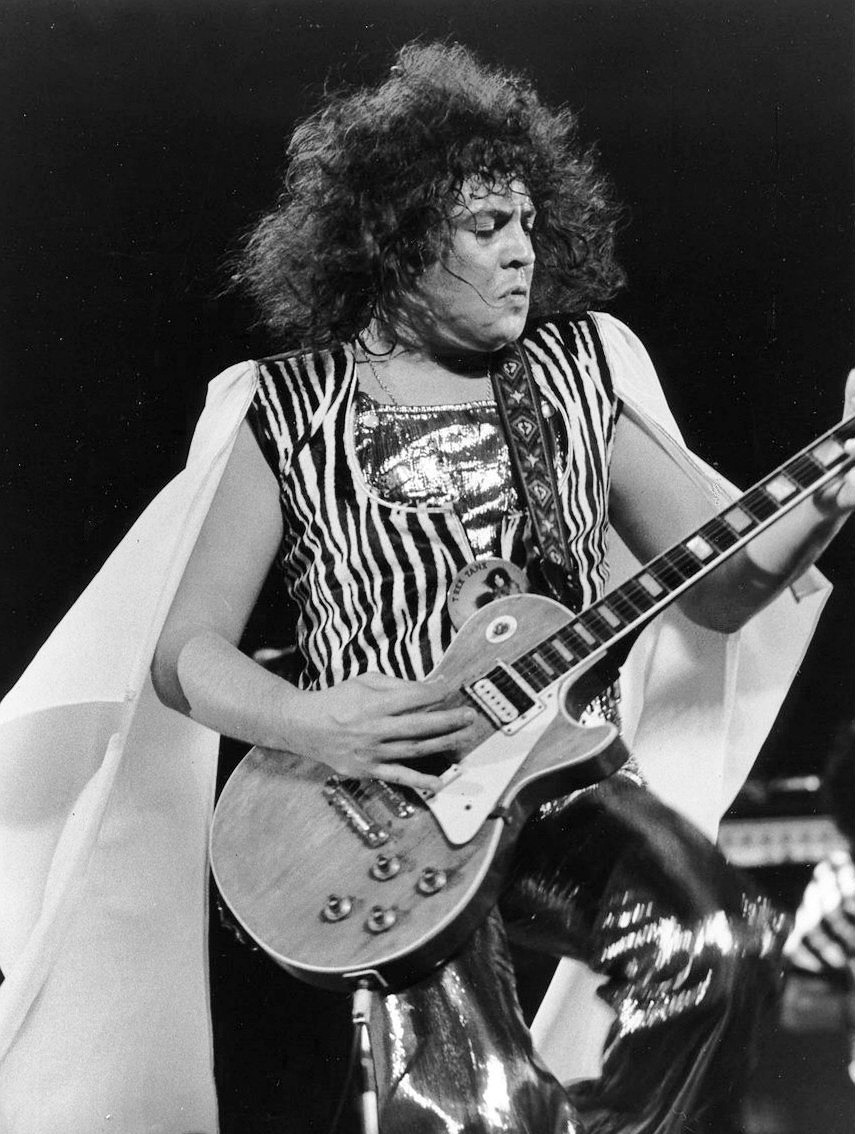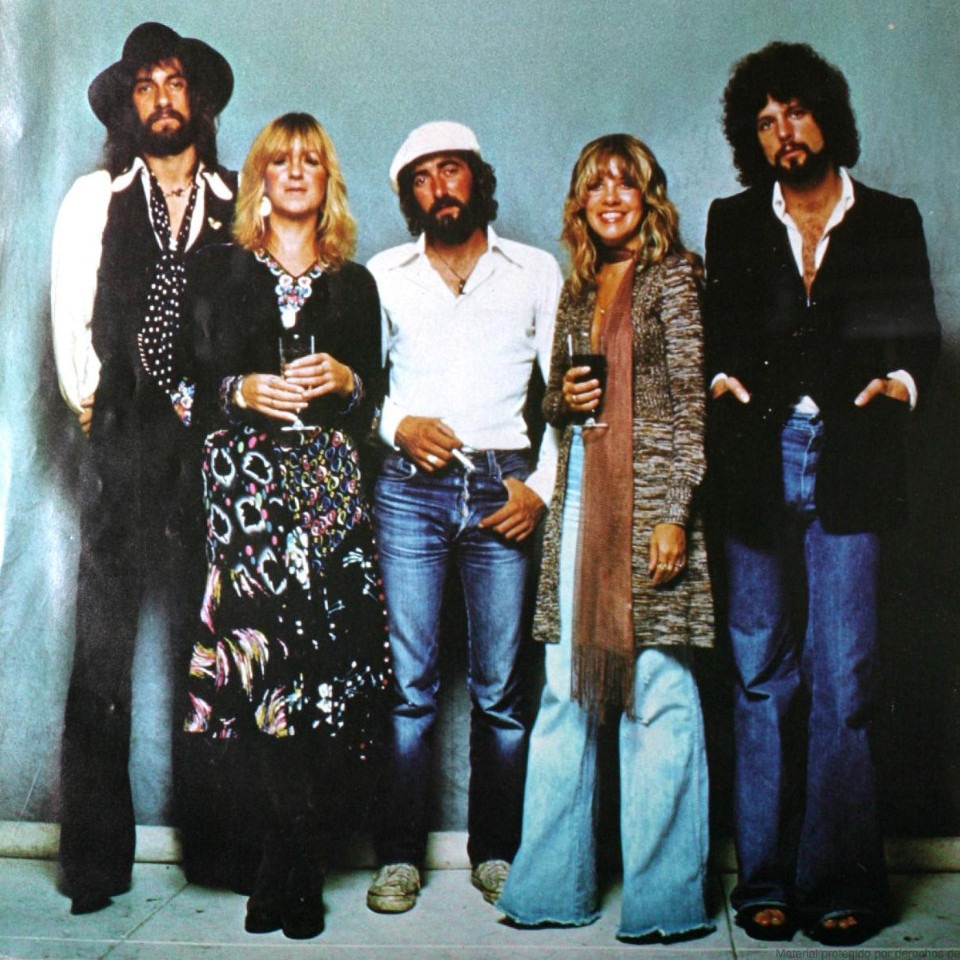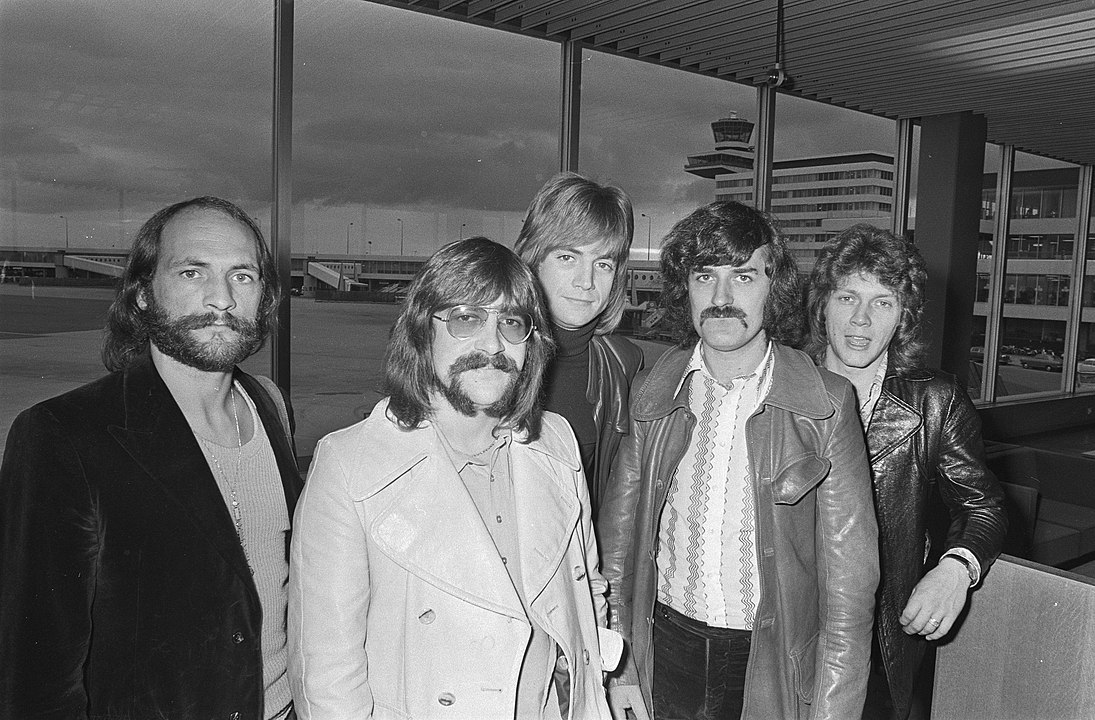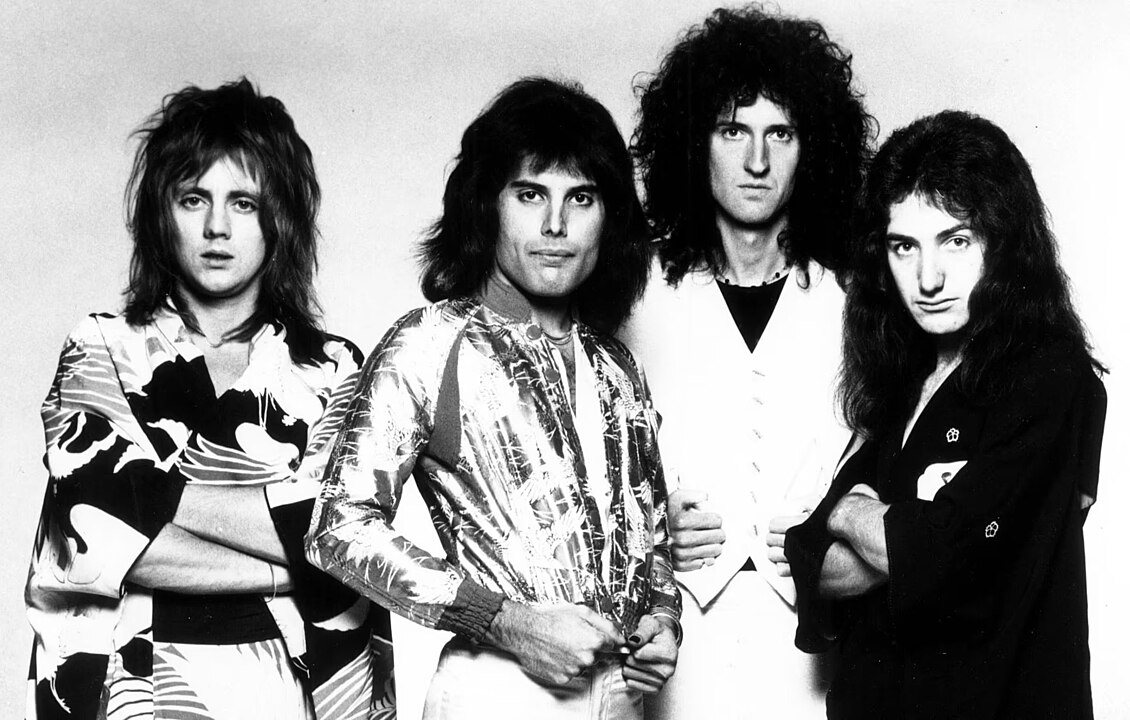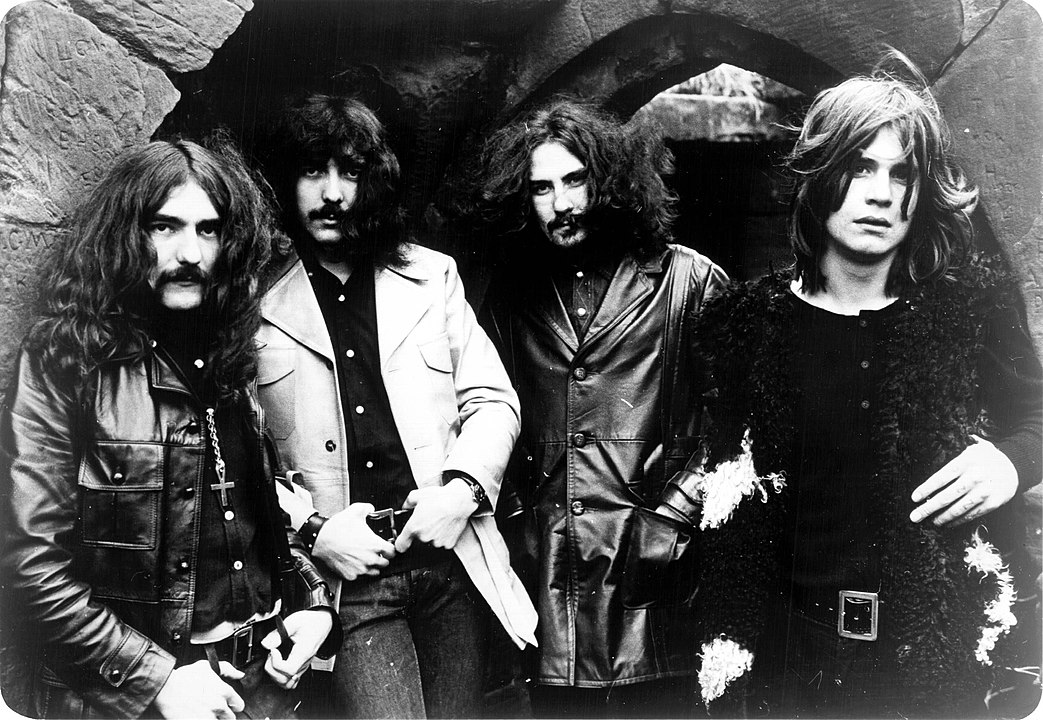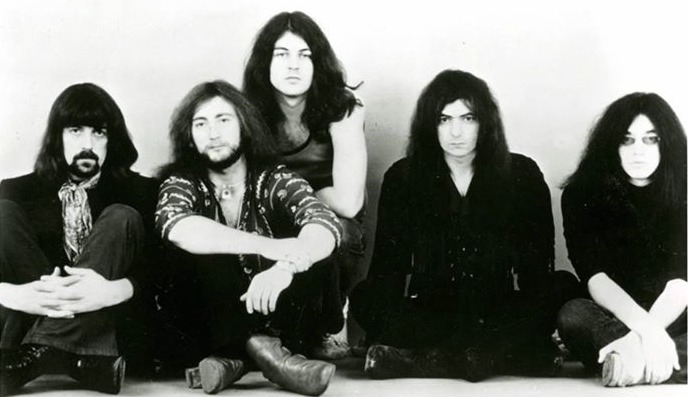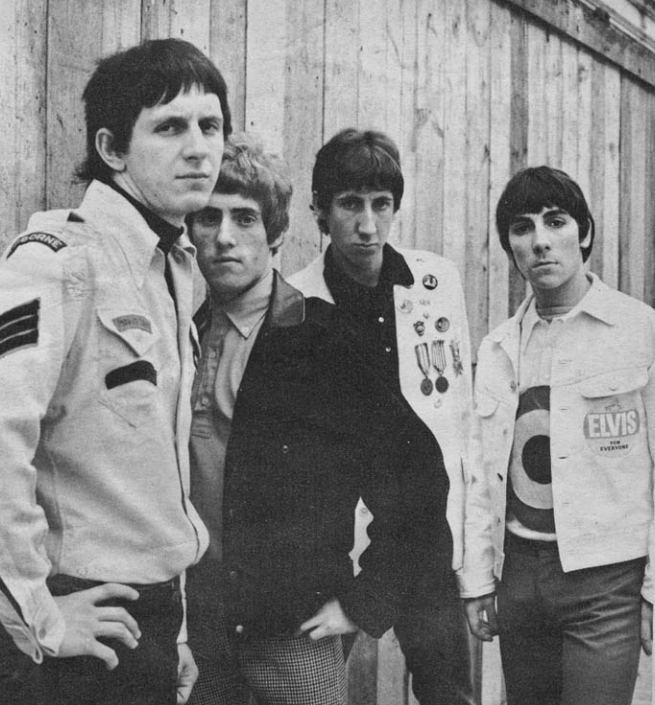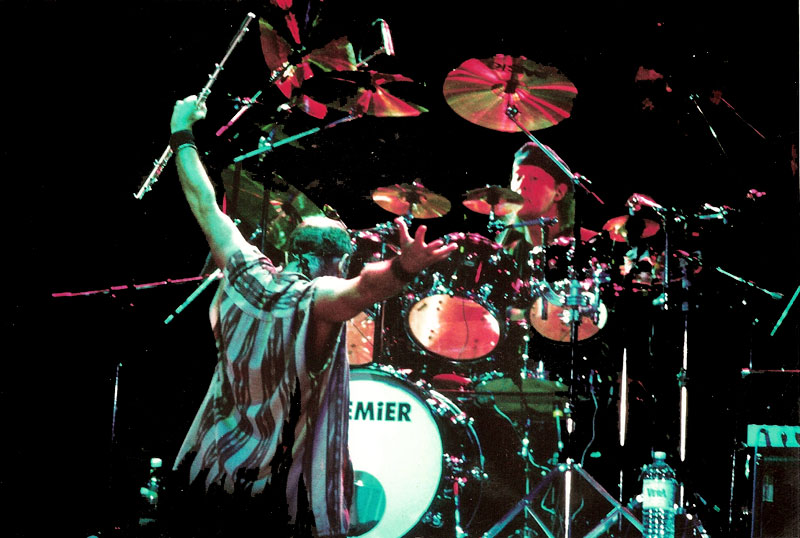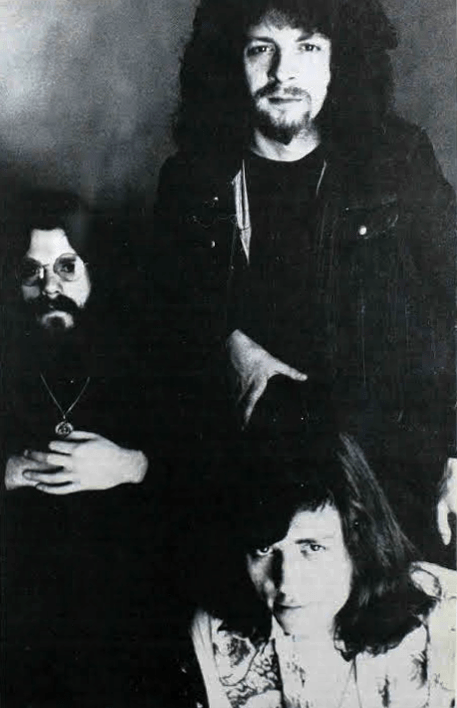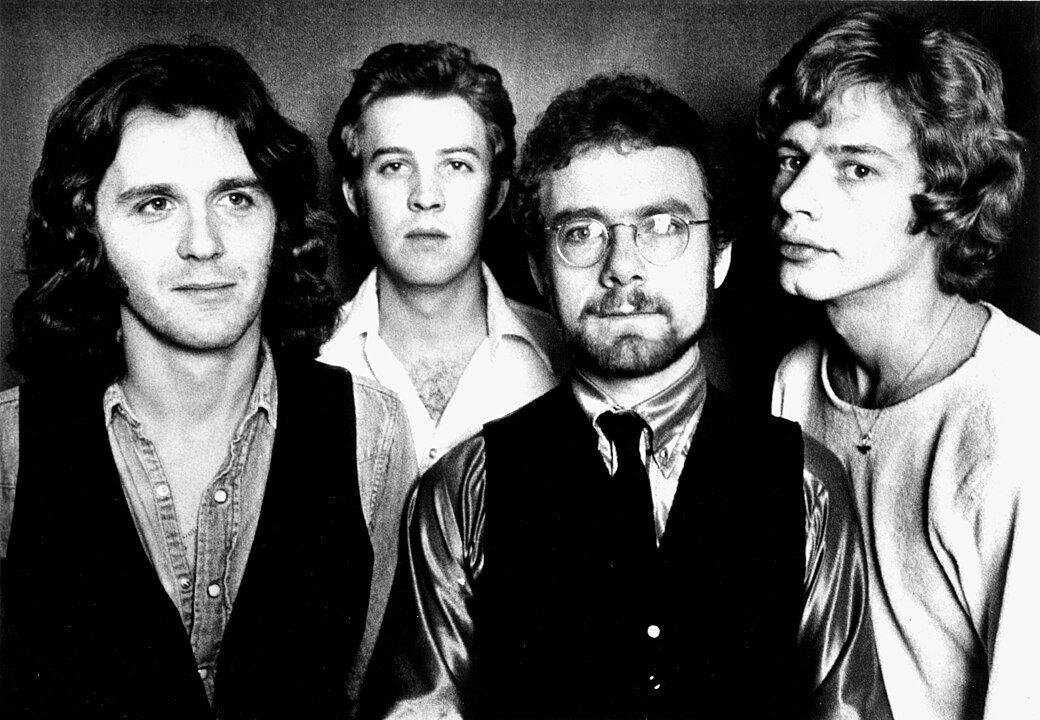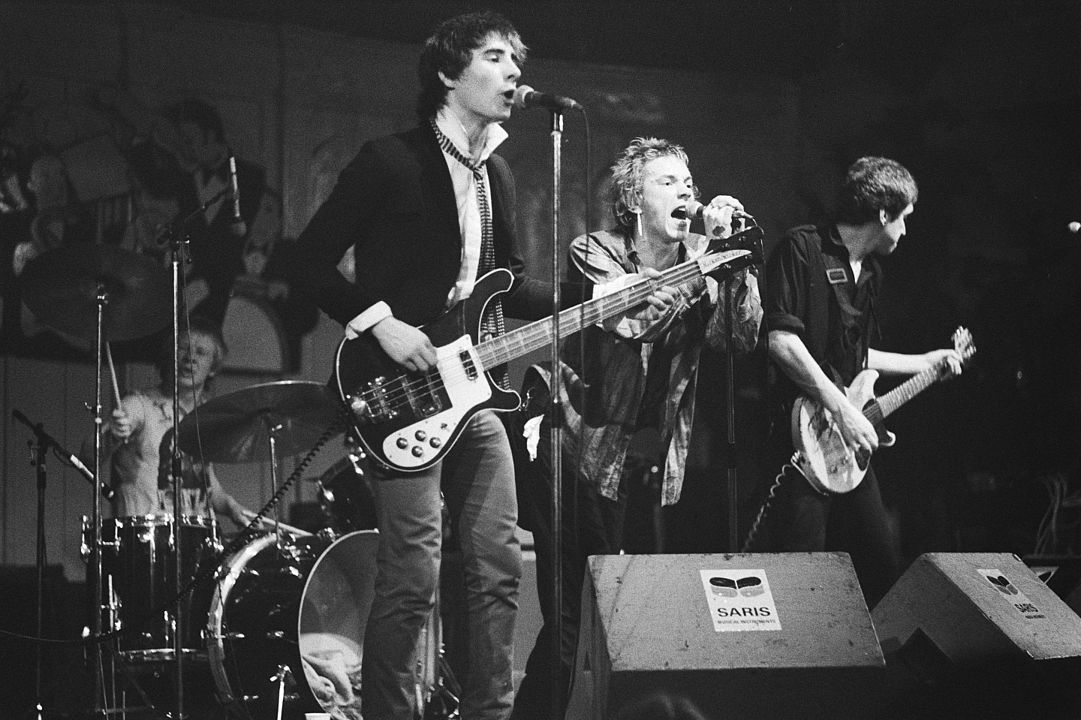The 1970s marked a pivotal moment for the UK’s music landscape, with bands at the forefront of a cultural revolution. Their music wasn’t just groundbreaking; the bands’ distinctive styles and flamboyant appearances significantly contributed to their allure. Despite critiques of their fashion choices, the chart-topping hits were undeniable, setting new records almost daily and establishing enduring trends.
From the electrifying performances of Queen to the enduring charisma of The Rolling Stones, the British pop scene of the ’70s was light years ahead in innovation and influence. Let’s take a nostalgic journey back in time to celebrate some of the iconic British bands that defined the vibrant music scene of the 1970s.
Slade
Slade, hailing from Wolverhampton, became one of England’s most famous bands. They burst onto the music scene in the early 70s and quickly rose to fame. They managed to land 17 of their records in the top 20, with six reaching the number one spot.
This success made Slade the top UK band of the 70s. They were the first to score three singles at number one. The lead singer, Noddy Holder, and Jim Lea, were behind the creation of these six chart-toppers. Their song “Merry Xmas Everybody” was a massive hit, selling over a million copies. In total, Slade has sold more than 50 million records worldwide.
Interesting Facts:
- Fact 1: Slade’s “Merry Xmas Everybody” is not just a festive hit; it’s an enduring Christmas anthem in the UK. Released in December 1973, the song has become synonymous with the holiday season, returning to the charts repeatedly over the decades. Its catchy chorus and festive spirit make it a staple of holiday playlists, contributing to Slade’s lasting legacy.
- Fact 2: Slade was at the forefront of the glam rock movement of the early 1970s. Their flamboyant fashion, characterized by platform shoes, glitter, and outlandish costumes, was as much a part of their identity as their music. This bold style, combined with their infectious tunes and charismatic performances, set them apart in a vibrant era of music history.
- Fact 3: Despite their peak fame in the 70s, Slade’s influence extended well beyond their heyday, inspiring a new generation of musicians. Notably, the band’s energetic sound and catchy hooks had a significant impact on the punk and new wave movements that followed. Bands like The Clash and The Ramones, as well as later groups like Oasis, have cited Slade as an influence, underscoring their impact on the evolution of rock music.
Pink Floyd
For a long time, there was a common misconception that Pink Floyd represented an individual artist rather than a band. In reality, during the 70s, Pink Floyd stood out as one of the premier British bands, initially making waves with notable hits in the 60s. Their rise to fame was fueled by their innovative approach to music and their penchant for pushing boundaries.
Furthermore, Pink Floyd was renowned for their captivating live performances, which were enhanced by innovative technology, elaborate lighting, and visual effects. Their underground performances played a significant role in building their reputation, setting the stage for their breakout success. By the time they emerged into the mainstream, they had already garnered a substantial following, allowing them to launch two hit singles and a highly successful debut album.
Roger Waters, the band’s lead vocalist and principal songwriter, played a pivotal role in crafting some of their most memorable tracks. Albums like “The Wall” and “Dark Side of the Moon” were not just commercial successes; they sold in the millions, securing their place as some of the most influential and best-selling albums in the realm of pop music.
Interesting Facts:
- Fact 1: Pink Floyd is renowned for creating some of the most iconic concept albums in music history. “The Dark Side of the Moon,” for example, explores themes of life, death, and human experience and remained on the Billboard 200 chart for an unprecedented 937 weeks from 1973 to 1988. Another of their albums, “The Wall,” is a rock opera that tells the story of a jaded rock star, reflecting Roger Waters’ own experiences, and it was turned into a full-length feature film in 1982.
- Fact 2: The band’s name, Pink Floyd, was derived from the names of two blues musicians, Pink Anderson and Floyd Council, whom Syd Barrett admired.
- Fact 3: Pink Floyd were pioneers in the use of state-of-the-art sound technology and elaborate stage shows. They were one of the first bands to use a quadraphonic sound system in their live performances, which created a multi-directional audio experience for the audience.
T-Rex
T-Rex, originally called Tyrannosaurus Rex, was a 70s band from England known for its acoustic tunes. The lead singer, Marc Bolan, decided to change their music to a more modern electric style, which was very popular then. So, they shortened their name to T-Rex.
Their song “Ride a White Swan” became a big hit and helped kick off the glam rock trend. T-Rex had a lot of success, with eleven top-ten hits and four number-one songs.
Marc Bolan was the mainstay of the band, always there as the songwriter and lead singer, even as other band members came and went. Sadly, Bolan died in a car crash in 1977, just after making the band’s last album.
Interesting Facts:
- Fact 1: T-Rex was instrumental in shaping the glam rock genre in the early 70s, characterized by their flamboyant style and the electric sound of hits like “Get It On” and “20th Century Boy.”
- Fact 2: Marc Bolan, the charismatic frontman of T-Rex, was known for his unique fashion sense, which included glitter, satin, and feather boas, helping to define the visual aspect of glam rock.
- Fact 3: The band’s dynamic journey was abruptly cut short by the untimely death of Marc Bolan in a car accident in 1977, just two weeks before his 30th birthday, marking the end of an era for T-Rex.
Fleetwood Mac
Formed in the late 60s, the Fleetwood Mac is a British-American band. In total, it is estimated that the band managed to sell over 100 million records globally. Therefore, it is one of the best-selling British bands in the world. In the beginning, the Fleetwood Mac was a British Blues band. At the time, the group had released “Albatross,” which was a number-one hit along with other smaller singles.
The year 1974 saw the band missing a lead singer since there were a lot of firings and members leaving the group. Mick Fleetwood was introduced to Lindsay Buckingham who was invited to play as a lead guitarist by Fleetwood. However, he signed on a condition that Stevie Nicks would also join the line-up of the Fleetwood Mac.
The new line-up offered the band a familiar sound. The first album of the new line-up ‘Fleetwood Mac’ was released with quite a bit of success. Following the album, another was released titled “Rumors,” which offered several hit singles. The album broke several records and pushed the band into the 70s superstardom.
Interesting Facts:
- Fact 1: Fleetwood Mac was named after two of its founding members, drummer Mick Fleetwood and bassist John McVie, combining their last names to form the band’s iconic name.
- Fact 2: Their 1977 album “Rumours” is one of the best-selling albums of all time, with over 40 million copies sold worldwide. The album was created amidst personal turmoil among band members, leading to emotionally charged songs that resonated with millions.
- Fact 3: Fleetwood Mac is known for its frequent lineup changes, with more than a dozen members over the years. Despite this, the band has maintained its distinctive sound and continued success across different musical eras.
The Moody Blues
The Moody Blues emerged in the mid-1960s as a trailblazing English rock band, initially steeped in blues influences but quickly evolving to craft a distinctively rhythmic sound. Their groundbreaking album, ‘Days of Future Passed,’ catapulted them to the forefront of the 1970s music scene, establishing them as pioneers of progressive rock.
This seminal album was lauded for its innovative fusion of classical and rock music, setting a new benchmark for concept albums with its rich, orchestral landscapes. Among the band’s most celebrated hits are the soulful “Go Now” and the hauntingly beautiful “Nights in White Satin.” Throughout their illustrious career, The Moody Blues have achieved global sales exceeding 70 million records, cementing their legacy in the annals of rock history.
Interesting Facts:
- Fact 1: The Moody Blues were among the first to fuse rock with classical music, notably with their album “Days of Future Passed,” which featured the London Festival Orchestra, blending rock and classical elements in a way that hadn’t been done before.
- Fact 2: The band was one of the early adopters of the Mellotron, a keyboard that simulates the sound of orchestral instruments. This instrument became a hallmark of their sound, particularly in their lush, atmospheric tracks like “Nights in White Satin.”
- Fact 3: After decades of influential music and a dedicated fanbase, The Moody Blues were inducted into the Rock and Roll Hall of Fame in 2018, a testament to their lasting impact on the music industry and progressive rock genre.
Queen
The 70s era cannot be discussed without mentioning Queen. Led by one of the greatest showmen in history, Freddie Mercury, the band was destined to be a huge success considering its music and the way the band presented it. It was not only Freddie Mercury serving as one of the strongest pillars but also guitarist Brian May, drummer Roger Taylor, and bassist John Deacon. In fact, Brian May is considered one of The 10 Best Guitarists of the 1970s, so the success of the band wasn’t reliant on Freddie Mercury alone.
Their song Bohemian Rhapsody, released in 1975, is a prime example of their unique musical approach. It was one of the very few bands at the time that could successfully experiment with different types of music. It was not only the song itself but the video as well that did rounds all over the world. Deemed as a very versatile group, the band produced disco, Radio Ga Ga, and Another One Bites the Dust, which were considered legendary hits for decades to come.
Interesting Facts:
- Fact 1: Brian May, Queen’s lead guitarist, is also an astrophysicist. An asteroid was named “17473 Freddiemercury” in honor of Freddie Mercury, Queen’s charismatic frontman, showcasing the unique blend of science and art within the band.
- Fact 2: Freddie Mercury, who studied graphic design, created Queen’s iconic logo, known as the “Queen crest.” The logo includes the zodiac signs of all four band members: two lions for Leo (John Deacon and Roger Taylor), a crab for Cancer (Brian May), and two fairies for Virgo (Freddie Mercury).
- Fact 3: Queen’s music transcends linguistic barriers. Their hit song “Teo Torriatte (Let Us Cling Together)” from the album “A Day at the Races” features choruses in Japanese, illustrating the band’s global appeal and Mercury’s love for experimenting with different cultural elements in music.
Led Zeppelin
According to some, Led Zepplin was the biggest English rock band of the 70s. The band, unlike others, received critical acclaim and worldwide success by focusing on releasing albums rather than singles. Even though they are recognized as a heavy rock group, Led Zepplin had much more versatility and subtlety to offer.
All this could be seen in their finest songs, such as ‘Stairway to Heaven. With Robert Plant as a rock god frontman and sublime talents such as guitarist Jimmy Page, drummer John Bonham, and bassist John Paul, there is a good reason why Led Zepplin is not considered the greatest British rock group of the 70s but of all time.
Interesting Facts:
- Fact 1: Led Zeppelin’s “Stairway to Heaven” is often considered one of the greatest rock songs of all time. Interestingly, the iconic guitar riff was composed in a small cottage named Bron-Yr-Aur in Wales, and the song was never released as a single, yet it became one of the most requested and played tracks on radio stations.
- Fact 2: For their untitled fourth album, often called “Led Zeppelin IV,” each band member chose a personal symbol to represent themselves on the album cover instead of their names or the band’s logo. This choice was part of their mystique and a statement against the music industry’s conventional marketing practices.
- Fact 3: Led Zeppelin was known for their electrifying live performances. In 1973, they set a world record for the largest attendance at a solo indoor concert, playing to approximately 56,000 fans at the Tampa Stadium in Florida, surpassing the Beatles’ previous record.
Black Sabbath
The Black Sabbath was formed in the 60s in Birmingham and is considered one of the top rock bands of the 70s. The band featured singer Ozzy Osbourne and was credited to be at the forefront of the heavy-metal music scene. The band had adopted its name from the movie sharing the same title and produced horror-inspired lyrics and music.
Their debut album was released in 1970 and received huge commercial success. The Rolling Stones Magazine, MTV, and VH1 hailed the band as one of the greatest metal bands and hard rock artists. In total, Black Sabbath managed to sell over 70 million records worldwide. As a result, they were inducted into the Rock and Roll Hall of Fame and the UK Music Hall of Fame as well. In addition to that, the band also managed to secure two Grammy awards and a Grammy Lifetime Achievement Award.
Interesting Facts:
- Fact 1: Black Sabbath is often credited with creating the heavy metal genre. Their eponymous debut album, “Black Sabbath,” released in 1970, featured the tritone, also known as the “devil’s interval,” in the song “Black Sabbath,” which became a defining sound for heavy metal music.
- Fact 2: Ozzy Osbourne, the band’s original lead vocalist, earned the nickname “The Prince of Darkness” due to his eerie, doom-laden lyrical themes and unique vocal style. His powerful voice has often been likened to an air raid siren, contributing to the band’s distinctive sound.
- Fact 3: Guitarist Tony Iommi lost the tips of two fingers in an industrial accident, leading him to use lighter strings and detune his guitar to make it easier to play. This created a darker, heavier sound that became a hallmark of Black Sabbath’s music and influenced the development of heavy metal.
Yes
Yes emerged in the late 1960s as a pioneering force in progressive rock, reaching the height of their popularity in the 1970s. Known for their intricate compositions, complex arrangements, and virtuosic musicianship, Yes crafted some of the most enduring and ambitious works of the era. Albums like “Fragile,” “Close to the Edge,” and “Tales from Topographic Oceans” exemplify their innovative approach to music, blending elements of classical, rock, and jazz with philosophical and cosmic themes.
The band’s lineup underwent numerous changes over the years, but members like Jon Anderson (vocals), Chris Squire (bass), and Steve Howe (guitar) were instrumental in shaping their distinctive sound. Yes’s live performances were legendary, featuring elaborate stage sets and cutting-edge sound and lighting, further solidifying their legacy as one of the most influential and celebrated bands in progressive rock.
Interesting Facts:
- Fact 1: Yes is renowned for their elaborate and fantastical album covers, most of which were created by artist Roger Dean. His distinctive, otherworldly landscapes and logo design became synonymous with the band’s identity and the progressive rock genre as a whole.
- Fact 2: In 1970, Yes released “Time and a Word,” their second album, which was notable for its ambitious use of a full orchestra. This endeavor marked one of the early fusions of rock and classical music, setting a precedent for the band’s future explorations in symphonic sound.
- Fact 3: Yes is known for its frequent lineup changes, with over 18 different musicians being part of the band throughout its history.
Genesis
Genesis, formed in 1967, is a British band that played a significant role in the development of progressive rock during the 1970s. With their intricate compositions, complex storytelling, and theatrical stage performances, Genesis carved a unique niche in the music world.
The band initially featured Peter Gabriel’s distinctive vocals and elaborate costumes, but following his departure in 1975, drummer Phil Collins stepped into the lead vocal role, marking a shift towards a more mainstream pop-rock sound. Albums like “Selling England by the Pound” and “The Lamb Lies Down on Broadway” are considered landmarks in the progressive genre, showcasing the band’s musical prowess and creative ambition.
Interesting Facts:
- Fact 1: Peter Gabriel was known for his elaborate stage costumes during live performances, including his famous “flower” and “fox” costumes, which added a theatrical dimension to the band’s concerts and became a hallmark of their early shows.
- Fact 2: Members of Genesis have enjoyed successful solo careers, with Phil Collins achieving global fame as a pop solo artist and Mike Rutherford founding the successful band Mike + The Mechanics.
- Fact 3: Genesis was inducted into the Rock and Roll Hall of Fame in 2010, a testament to their enduring influence and contribution to the music industry.
The Clash
The Clash, formed in 1976 in London, was a pivotal force in the original wave of British punk rock. Known for their potent mix of punk’s raw energy with elements of reggae, ska, and rockabilly, The Clash stood out for their politically charged lyrics and rebellious attitude. Unlike many of their contemporaries, they infused their music with a sense of social and political urgency, addressing issues like social injustice, war, and the struggles of the working class.
The band’s lineup, most famously consisting of Joe Strummer (vocals, rhythm guitar), Mick Jones (lead guitar, vocals), Paul Simonon (bass guitar), and Topper Headon (drums), was pivotal in crafting their distinctive sound. Albums like “London Calling” and “Combat Rock” have left an indelible mark on the music landscape, with “London Calling” often cited as one of the greatest rock albums of all time. The Clash’s ability to blend different musical styles with an unapologetic social commentary helped them to transcend the punk scene and achieve widespread critical and commercial success.
Interesting Facts:
- Fact 1: The cover of “London Calling,” featuring Paul Simonon smashing his bass guitar on stage, is one of the most iconic images in rock music, capturing the band’s raw, explosive energy.
- Fact 2: The hit song “Rock the Casbah” from the album “Combat Rock” was inspired by the ban on Western music in Iran following the 1979 Islamic Revolution, showcasing the band’s engagement with global political issues.
- Fact 3: The Clash was inducted into the Rock and Roll Hall of Fame in 2003, solidifying their position as one of the most influential and enduring bands of the punk era.
Deep Purple
Deep Purple, formed in Hertford, England, in 1968, is hailed as one of the pioneering bands of the hard rock and heavy metal genres. Known for their blistering live performances and groundbreaking sound, they melded elements of classical music, blues, and rock to create something entirely new and powerful. The band’s most famous lineup, known as Mark II, consisted of Ian Gillan (vocals), Ritchie Blackmore (guitar), Jon Lord (keyboards), Roger Glover (bass), and Ian Paice (drums), and was responsible for producing some of their most iconic work.
Deep Purple gained massive popularity with albums like “In Rock” and “Machine Head,” the latter of which featured “Smoke on the Water,” a song with one of the most recognizable guitar riffs in rock history. The story behind the song, involving a fire that broke out during a Frank Zappa concert in Montreux, Switzerland, has become legendary. Over the years, Deep Purple underwent numerous lineup changes but continued to influence countless bands and musicians with their heavy sound and virtuosic musicianship.
Interesting Facts:
- Fact 1: In 1972, Deep Purple was listed in the Guinness Book of World Records as the “globe’s loudest band” after a concert at the Rainbow Theatre in London reportedly rendered three fans unconscious.
- Fact 2: Their 1969 album “Concerto for Group and Orchestra” was one of the first attempts to fuse rock music with classical, performed with the Royal Philharmonic Orchestra and conducted by Malcolm Arnold, showcasing the band’s innovative approach to music.
- Fact 3: Deep Purple was inducted into the Rock and Roll Hall of Fame in 2016, a testament to their enduring impact on the music world and their role in the creation and development of the hard rock and heavy metal genres.
The Who
The Who, formed in London in 1964, stands as one of rock music’s most influential and dynamic bands. Comprised of Roger Daltrey (vocals), Pete Townshend (guitar), John Entwistle (bass), and Keith Moon (drums), The Who were renowned for their energetic live performances, which often included the destruction of their instruments on stage.
Their groundbreaking work includes pioneering the rock opera with albums such as “Tommy” and “Quadrophenia,” which showcased the band’s ambitious storytelling through music. Hits like “My Generation,” “Baba O’Riley,” and “Won’t Get Fooled Again” display their blend of rock, power pop, and art rock, leaving a lasting legacy on the rock genre. The Who’s contributions to music, along with their theatrical stage presence, have cemented their place as icons in rock history.
Interesting Facts:
- Fact 1: The Who’s Pete Townshend is credited with pioneering the use of feedback in rock music, famously showcased in the track “Anyway, Anyhow, Anywhere.” This innovative guitar technique became a staple in rock and influenced countless musicians.
- Fact 2: The Who were among the first to conceptualize and execute the idea of a rock opera, with their 1969 album “Tommy” telling a cohesive story through its songs. This groundbreaking approach expanded the possibilities of rock music as a narrative form.
- Fact 3: The Who were notorious for their explosive live shows, where they would often smash their instruments on stage as part of their performance. This act of destruction became a signature part of their identity and a symbol of rock rebellion.
Emerson, Lake & Palmer
Emerson, Lake & Palmer (ELP) was a British progressive rock supergroup formed in 1970, consisting of keyboardist Keith Emerson, bassist/guitarist/vocalist Greg Lake, and drummer Carl Palmer. Known for their virtuosic musicianship and elaborate live shows, ELP combined classical music influences with rock, jazz, and symphonic elements, creating a distinctive and ambitious sound that set them apart in the progressive rock genre.
Their self-titled debut album was a commercial success, and they quickly became known for their ambitious concept albums, such as “Tarkus” and “Brain Salad Surgery.” ELP’s music was characterized by technical proficiency, complex compositions, and the use of cutting-edge technology, including synthesizers and elaborate stage setups. Despite their success, the band faced criticism for their perceived extravagance and the complexity of their music.
Interesting Facts:
- Fact 1: Keith Emerson was known for his dramatic keyboard playing techniques, including using knives to wedge between keys for sustained notes during performances. These knives were not ordinary but were gifted to him by Lemmy Kilmister, who was a roadie for the band before joining Hawkwind and later forming Motörhead.
- Fact 2: Emerson, Lake & Palmer were pioneers in blending classical music with rock, creating rock versions of classical pieces. Their adaptation of Mussorgsky’s “Pictures at an Exhibition” was particularly notable, showcasing their ability to reinterpret classical works through a progressive rock lens.
- Fact 3: Carl Palmer was known for his elaborate drum setups, one of which was recognized by the Guinness Book of World Records as the world’s largest drum kit at the time, featuring an array of drums, cymbals, and gongs, underscoring the band’s commitment to musical and visual spectacle.
The Kinks
The Kinks, formed in North London in 1964 by brothers Ray and Dave Davies, are one of the most influential rock bands of the 1960s and 1970s. Known for their distinctive sound, marked by innovative guitar effects and reflective lyrics, The Kinks scored numerous hits, including “You Really Got Me,” “Waterloo Sunset,” and “Lola.” Their music, ranging from hard rock to more melodic ballads, played a significant role in the British Invasion of the US music scene and left a lasting impact on rock and pop music.
Interesting Facts:
- Fact 1: The gritty guitar sound on “You Really Got Me” was achieved by Dave Davies slicing the speaker cone of his amplifier with a razor blade, a technique that contributed to the development of hard rock and heavy metal.
- Fact 2: At the height of their fame, The Kinks were banned from performing in the United States for four years due to disputes with the American Federation of Musicians, significantly impacting their international success during a crucial period.
- Fact 3: The Kinks were among the first rock bands to produce concept albums, with “Arthur (Or the Decline and Fall of the British Empire)” telling a cohesive story through its songs and predating many similar efforts by other rock bands.
Jethro Tull
Jethro Tull, formed in Blackpool, England, in 1967 by frontman Ian Anderson, stands out for its unique blend of rock, folk, and classical music influences, all woven together with Anderson’s signature flute playing. Known for their theatrical live performances and complex compositions, the band achieved critical and commercial success with albums like “Aqualung” and “Thick as a Brick.” Their distinctive sound and storytelling lyrics have cemented Jethro Tull’s place as one of the most innovative and enduring bands in the progressive rock genre.
Interesting Facts:
- Fact 1: Ian Anderson turned to the flute after finding himself unable to compete with the electric guitarists in the band. His self-taught, unconventional playing style became a defining characteristic of Jethro Tull’s sound.
- Fact 2: In 1989, Jethro Tull won the Grammy Award for Best Hard Rock/Metal Performance, controversially beating out Metallica. The award was so unexpected that it led to the creation of separate categories for Hard Rock and Metal in subsequent years.
- Fact 3: The band’s name, Jethro Tull, was taken from an 18th-century agriculturist known for inventing the seed drill. The name was suggested by a history-savvy booking agent, and it stuck despite having no real connection to the band’s music.
Electric Light Orchestra (ELO)
Electric Light Orchestra (ELO), formed in Birmingham, England, in 1970 by Jeff Lynne and Roy Wood, is celebrated for its innovative fusion of rock, pop, and classical music, featuring elaborate orchestrations and futuristic themes. Lynne’s vision led ELO to create a distinctive sound characterized by catchy melodies, lush strings, and intricate harmonies, achieving widespread acclaim with hits like “Mr. Blue Sky” and “Don’t Bring Me Down.” ELO’s ambitious productions and visually stunning live performances made them one of the defining groups of the 1970s and beyond.
Interesting Facts:
- Fact 1: ELO is famous for their elaborate live shows, notably using a giant spaceship as part of their stage setup during the “Out of the Blue” tour, enhancing their futuristic image.
- Fact 2: ELO is famous for their elaborate live shows, notably using a giant spaceship as part of their stage setup during the “Out of the Blue” tour, enhancing their futuristic image.
- Fact 3: In 2012, ELO’s “Mr. Blue Sky” was chosen for the Voyager Golden Record, a phonograph record sent into space aboard the Voyager spacecraft as a representation of the diversity of life and culture on Earth.
King Crimson
King Crimson, formed in London in 1969 by guitarist Robert Fripp, is renowned for its influential contributions to progressive rock. The band’s debut album, “In the Court of the Crimson King,” is a seminal work that defined the genre with its complex musical structures, intricate instrumentals, and philosophical lyrics. King Crimson’s ever-evolving lineup and willingness to explore new musical territories have kept them at the forefront of progressive and experimental music, making them one of the most enduring and innovative bands in the genre.
Interesting Facts:
- Fact 1: King Crimson is known for its frequent lineup changes, with guitarist Robert Fripp being the only constant member throughout the band’s history, contributing to their constantly evolving sound.
- Fact 2: Their debut album, “In the Court of the Crimson King,” is often cited as one of the most influential progressive rock albums ever, with its iconic cover art becoming synonymous with the genre.
- Fact 3: Members of King Crimson have been involved in numerous collaborations and side projects, including work with David Bowie, Brian Eno, and Peter Gabriel, showcasing the band’s wide-ranging influence across the music industry.
Sex Pistols
The Sex Pistols, formed in London in 1975, were a revolutionary force in the punk rock movement, known for their aggressive sound, anti-establishment lyrics, and controversial antics. With Johnny Rotten on vocals, Steve Jones on guitar, Glen Matlock (later replaced by Sid Vicious) on bass, and Paul Cook on drums, they challenged societal norms and the music industry’s conventions. Their single “Anarchy in the UK” and the album “Never Mind the Bollocks, Here’s the Sex Pistols” became anthems of rebellion, making them one of the most iconic and influential punk bands despite their brief existence.
Interesting Facts:
- Fact 1: The Sex Pistols were together for just two and a half years and released only one studio album, yet they left a lasting impact on the music scene and youth culture.
- Fact 2: Their 1976 appearance on the “Today” show, where they used profanity live on air, resulted in widespread media outrage and catapulted them to infamy.
- Fact 3: The Sex Pistols were inducted into the Rock and Roll Hall of Fame in 2006, but they refused to attend the ceremony, calling the institution “a piss stain” in a handwritten note.
The Jam
The Jam, formed in Woking, England, in 1972 by Paul Weller, Bruce Foxton, and Rick Buckler, was a prominent band in the British punk and mod revival scene of the late 1970s and early 1980s. Known for their sharp suits and tight performances, The Jam blended the energy of punk with the melodic R&B influences of the 1960s mod culture, creating a unique sound that resonated with British youth. With hits like “Town Called Malice” and “Going Underground,” The Jam delivered socially conscious lyrics and catchy tunes, making them one of the most popular bands in the UK during their career.
Interesting Facts:
Fact 1: The Jam were at the forefront of the mod revival movement, a subculture that emerged in the late 1970s, drawing inspiration from the fashion, music, and attitudes of the 1960s mod scene.
Fact 2: The Jam achieved an impressive 18 consecutive Top 40 singles in the UK from their debut in 1977 to their breakup in 1982, including four number-one hits.
Fact 3: After The Jam disbanded in 1982, Paul Weller went on to form the Style Council and later enjoyed a successful solo career, earning the nickname “The Modfather” for his continuing influence on British music and fashion.
Conclusion
The British band scene of the 70s was monumental for both aficionados and the broader musical landscape. While numerous other groups could be acknowledged, the ones previously discussed have left the deepest imprint. Despite facing lineup shifts and various challenges, these bands delivered some of the most iconic hits known today. Grasping the essence and influence of the 70s era necessitates a deep dive into the contributions these bands made during that vibrant period.

